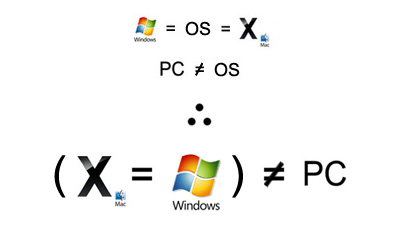Paulo Ávila
A Mac is a PC
“The use of the terms PC and Mac to differentiate computers that run the Microsoft Windows operating system between those that run Apple OS X is technically incorrect...…”
Words: 690
“Hello, I’m a Mac…but I’m also a PC.”
The use of the terms PC and Mac to differentiate computers that run the Microsoft Windows operating system between those that run Apple OS X is technically incorrect. A few years back, Mac was simply an abbreviation for Macintosh (the brand of computers made by Apple Inc.) and PC was an acronym for Personal Computer (those used in the home/office, etc.). Recently, however, these words have changed their connotations and this transformation hasn’t been accidental.
Before I speculate how or why, let’s cover some basics. Both and Microsoft and Apple Inc. are software/hardware companies:</p>

Microsoft develops the popular operating system “Windows” but they don’t actually manufacture the computers that it runs on. They leave it up to other companies such as Lenovo, HP, Dell, Gateway and even Apple (after the transition from the PowerPC line of processors to the Intel chip) to make hardware that is compatible with their OS. Then these individual companies give their computers their own names (i.e. the HP Pavillion or the Gateway LT Series). So for example, as a consumer you can own a Dell Inspiron that runs Microsoft Windows (God forbid that actually be the case).
On the other hand, Apple develops the “X” operating system (OS X)* and manufactures the computers that run it. Furthermore (and unlike Microsoft) Apple doesn’t allow other companies to make computers that run their “ground-breaking” operating system — Apple handles it all. So as a consumer, you can’t for example, own an HP Pavillion that runs Apple OS X. If you want Apple’s OS you need to go get an Apple computer (which has a brand name of “Mac”).
In this regard, Apple is a monopoly; they have complete control of the hardware and operating system. And the marriage between the two is very closely knit. So much so, that in this case there’s no need to identify both the kind of computer and which operating system it runs. The entire package is simply referred to as “a Mac.” This inseparable unification of hardware and software that Apple maintains is what I think has made a “Mac” represent much more than simply a brand name.

At the same time, Apple has made efforts to practically abandoned “PC” as a label for anything about them by inaccurately using the label “PC” as an umbrella phrase to encompass everything that is not a Mac (specifically referring to computers that run Windows).
Clever marketing campaigns such as the popular “Hi, I’m a Mac. And I’m a PC” ads have only aided the separation of the two terms. In fact, their tactics have been an effective way to even change the connotation of what a “PC” refers to by attaching a feeling that non-Macs (i.e. PCs) are boring and old-fashioned. The ingenuity is that they’ve been detached from the status quo. People now state: “I’m a PC user” when they should be saying: “I’m a Windows user” to distinguish themselves from “Mac users.”
But it goes even farther than that: similarly to how they made an application sound cool again (by using app instead of a-ppli-ca-tion), through the wonderous and magical means of marketing the word Mac has come to represent the entire experience of owning a computer from Apple.
Why the hell did I write this post? I don’t have to tell you everything. Just realize that your laptop, desktop, or whatever-top is a PC, regardless of what operating system it’s running!
*Contrary to what most people think, Apple’s OS X only officially became recognized as UNIX as of version 10.5 (Leopard).